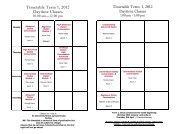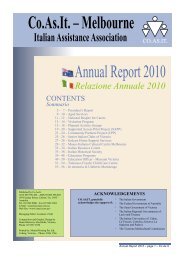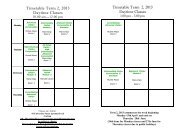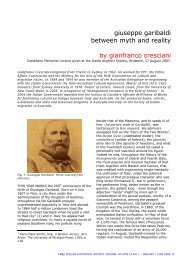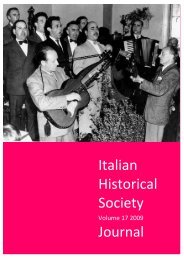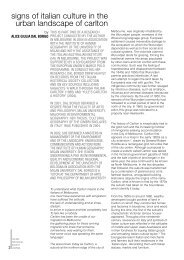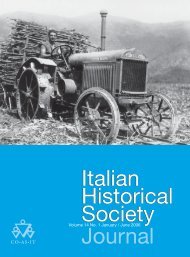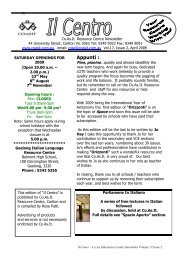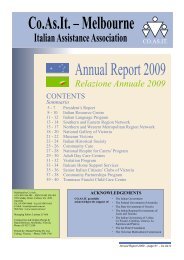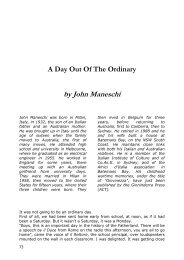January-December 2010, vol. 1
January-December 2010, vol. 1
January-December 2010, vol. 1
- No tags were found...
Create successful ePaper yourself
Turn your PDF publications into a flip-book with our unique Google optimized e-Paper software.
Researchers Dr Bruno Mascitelli and Dr SimoneBattiston commemorated the occasion with thepublication, Il Globo. Fifty Years of an ItalianNewspaper in Australia, a comprehensiveassessment and recollection of the newspaper’srecording of the migration program, thedefence of Italians in Australia as well as whatwas making news back in Italy. The book isdivided into seven chronological and themebasedchapters: 1. The first 50 years; 2. 1959-1969: An early voice of Italians in Australia; 3.1969-1979: A turbulent decade; 4. How theItalian-Australian left and its press viewed IlGlobo; 5. A community paper for a changingcommunity; 6. The newspaper for an ‘imaginedcommunity’; and 7. Gli anni ruggenti: NinoRandazzo, journalist/editor of Il Globo andplaywright, Gaetano Rando.migration institutes & museumsSotto tutti i cieli. Immagini e documenti delmuseo Paolo Cresci per la storiadell’emigrazione italiana, Lucca: Museo PaoloCresci dell’emigrazione italianae TipografiaTommasi, 2008.The Paolo Cresci Museum for the History ofItalian Emigration, created by the Province ofLucca, studies the history and problems ofemigration. The Foundation is named afterFlorentine researcher Paolo Cresci (1943-1997),whose archives are also held by the Museum.This catalogue is divided into chapters devotedto the main features or themes of emigration –from its causes to the choice of destination,conditions during the journey and on arrival,employment and other issues. It aims to offer apractical guide for those wishing to know moreabout the topic of emigration and also describesthe collections of the Museum. The book iswritten in Italian, English and Spanish.subsidiary of the Centro Studi “Joseph Tusiani”in San Marco in Lamis) covers a diverse range oftopics. Essays include ‘Carlo Tresca: il dilemma diun radical anticomunista’ by Gerald Meyer;‘Un’intervista inedita a Carlo Levi’ by RobertoRuberto; ‘Dal paese alla città: Michele Parrella’edited by Sergio D’Amaro; and ‘Emigrazione/immigrazione: ricordo nostalgico delsentimento’ by Luigi Lizzardo.Centro Studi ‘Joseph Tusiani’, Frontiere, AnnoIX, Numeri 17-18, Gennaio-Dicembre, 2008.Numbers 17-18 of the bulletin comprises articlessuch as ‘La scoperta dell’America’ by GaetanoQuagliariello; ‘Esuli pensieri. La letteraturaitaloamericana in un importante convegno aFoggia’ by Ernesto L’Arab; and ‘La “monelleriavagante”: gli schiavi-bambini dell’800’ byMassimo Tardio. Also included in this edition is asmall supplement entitled ‘Buon CompleannoJoseph!’ The supplement celebrates theeightieth birthday anniversary of theFoundation’s namesake and founder, JosephTusiani. It includes examples of his eloquentpoetry as well as some short yet informativearticles on the Centre and Tusiani himself.Nicosia, Alessandro; Prencipe, Lorenzo (eds.),Museo Nazionale Emigrazione Italiana, Roma:Museo Nazionale Emigrazione Italiana eGangemi Editore, 2009.Published to inaugurate the Italian NationalMuseum of Emigration in 2009, this richpublication entrusts itself with the task ofcontributing to a more detailed understandingof Italian emigration. The book pays particularattention to emigration from the late 18 thcentury to the present day, conscious ofpositioning emigration within the relevantpolitical, economic and social context. The highquality of this 500 page publication is testamentto the importance that the current ItalianMinistry of Foreign Affairs places on the historyof Italian migration abroad. The book is adornedwith colour reproductions of photographs,documents and ephemera, data and statisticaltables and various academically written andresearched essays. Topics focus on the history ofmigration, the Italian diaspora abroad, and therepresentation of emigration in Italian cinema.Ostuni, Maria Rosaria, Storia/storiedell’emigrazione toscana nel mondo, Lucca:Tipografia Tommasi, 2006.This publication heralds a series of “Quaderni”or notebooks on immigration that intend to giveimpetus to the Foundation’s research andstudies, and to publicise the knowledge that thisimportant phenomenon has significantlyimpacted on the political and social history ofItaly over the last 150 years.This <strong>vol</strong>ume tells the story of Tuscanimmigration; to date a relatively under-studiedfield. The publication, complete withphotographic reproductions, commences with awell-researched essay by Maria Rosaria Ostuni.Thirty-three primary accounts by Tuscanmigrants follow the introductory essay.Centro Studi ‘Joseph Tusiani’, Frontiere, AnnoIX, Numeri 15-16, Giugno-Dicembre, 2007.The six-monthly bulletin of the Centro diDocumentazione sulla Storia e la Letteraturadell’Emigrazione della Capitanata (CDEC)Paolini, Davide; Seppilli, Tullio; Sorbini,Alberto (eds.), 1. Migrazioni e culturealimentari, I Quaderni del Museodell’Emigrazione, Foligno: Editoriale Umbria,2002.The Journal of the Immigration Museum is aneditorial initiative of the Museo Regionaledell’Emigrazione Pietro Conti di Gualdo Tadino.Migrazioni e culture alimentari is the first editionin a series which endeavours to analyse variousthemes, features and recent phenomena of themigration process.This <strong>vol</strong>ume investigates the numerous andcomplex effects of the migration process onfood. It focuses, for example, on the types ofingredients utilised, the approach to foodpreparation and the development of an Italianfood industry beyond a national context. Thequestions posed are supported by a case studywhich considers the transformation of culinarypatterns of Italian migrants to America.Nardelli, Dino Renato (ed.), 2. Per terre assailontane. Dalla storia delle migrazioni ad unanuova idea di cittadinanza, I Quaderni delMuseo dell’Emigrazione, Foligno: EditorialeUmbria, 2002.IHSJ ITALIAN HISTORICAL SOCIETY JOURNAL VOLUME 18 <strong>2010</strong> | 55



